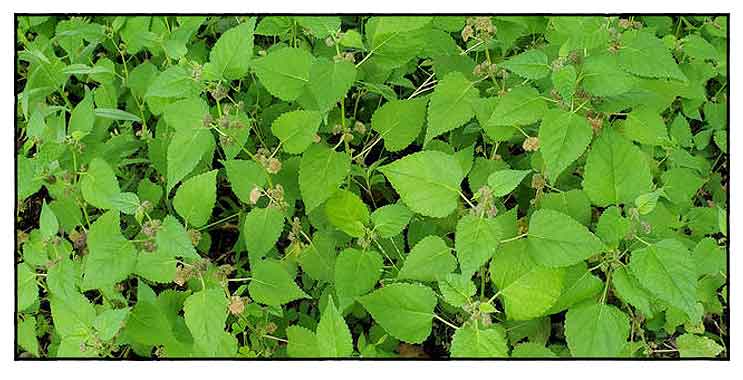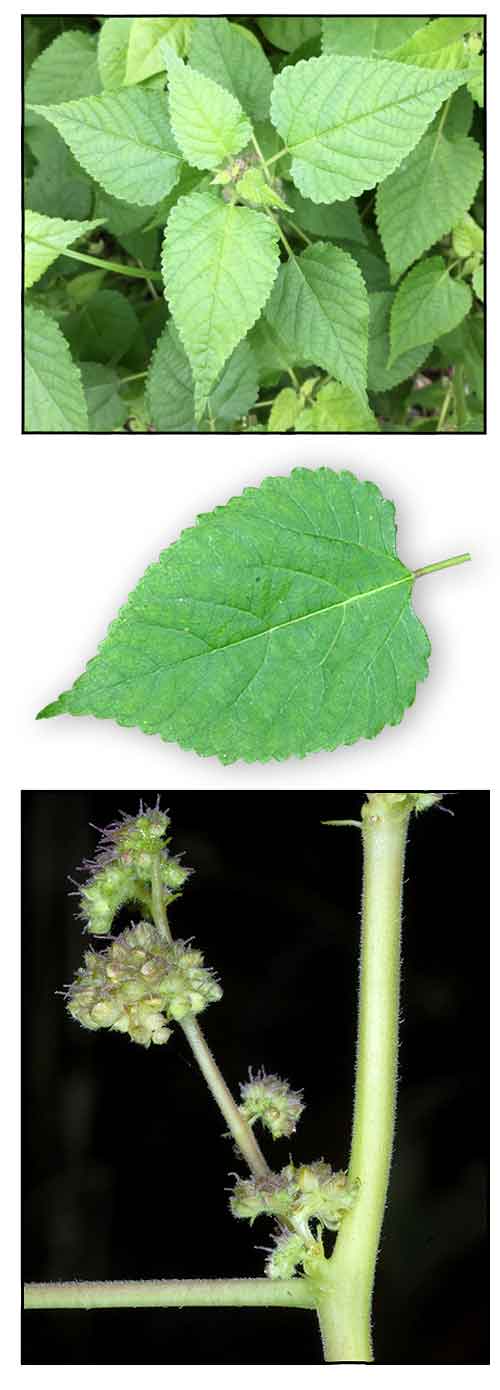
Family • Moraceae
Malbas-damo
Fatoua villosa (Thunb.) Nakai
CRABWEED / MULBERRY WEED
Shui she ma
| Scientific names | Common names |
| Boehmeriopsis pallida Kom. | Sikir (General) |
| Fatoua aspera Gaudich. | Malbas-damo (Tagalog) |
| Fatoua cordata Gaudich. | Sarungkar-a-babassit (Iloko) |
| Fatoua globulifera Miq. | Crabweed (Engl.) |
| Fatoua japonica (Thunb.) Blume | Foolish weed (Engl.) |
| Fatoua lanceolata Decne. | Hairy crabweed (Engl.) |
| Fatoua pilosa var. cordata (Gaudich.) Bureau | Hairy fatoua (Engl.) |
| Fatoua pilosa subvar. glechomifolia (Miq.) Bureau | Mulberry weed (Engl.) |
| Fatoua pilosa subvar. globulifera (Miq.) Bureau | Snake hemp (Engl.) |
| Fatoua pilosa var. lanceolata Bureau | Watersnake hemp (Engl.) |
| Fatoua scabra Miq. | |
| Fatoua subcordata Gaudich. | |
| Fleurya glechomifolia Miq. | |
| Fleurya globulifera Miq.. | |
| Fleurya scabra Miq. | |
| Urtica japonica Thunb. | |
| Urtica villosa Thunb | |
| Fatoua villosa is an accepted species. KEW: Plants of the World Online | |
| Taxonomy conflict: Some compilations list Fatoua villosa and F. pilosa as synonyms; others as separate species. | |
| Sikir is a common name shared by both Fatoua pilosa and F. villosa. | |
| Other vernacular names |
| CHIN A : Shui she ma, Xiao shema (Mandarin). |
| INDONESIA: Akar kuning (Malay, Timor); Ranggitan (Javanese); Utu guraci (Ternate); Murbel liar, Ba' molo. |
| JAPAN: Kuwaskusa. |
| VIETNAM: D[aa]u b[is]ch, Du[oos]i c[or]. |
• F. villosa is an annual herb, and sometimes perennial herb in the deep south of the US. The entire plant is covered in both glandular and recurved hairs giving the plant a sticky feeling to the touch. The leaves resemble the leaves of mulberry giving rise to the common name of mulberry-weed. Leaves are heart shaped and up to 10 cm long with a crenate leaf margin. At the base of each leaf is a pair of stipules. It is a monoecious plant meaning that it has separate male and female flowers on the same plant. The male and female flowers are aggregated into axillary clusters. Fruit is single seeded and explosively shoots the seed up to several meters. (3) Distribution Constituents Properties Studies Availability |
July 2025
![]()
 |
| Â Â Â Â Â Â Â Â Â Â Â Â Â Â Â Â Â Â Â Â Â Â Â Â Â PHOTOS / ILLUSTRATIONS |
| IMAGE SOURCE: Hairy crabweed (Fatoua villosa) / © craghorne / Sll rights reserved / Non-comercial use / Click on image or link to go to source page / iNaturalist |
| OTHER IMAGE SOURCE: Hairy crabweed (Fatoua villosa) / © craghorne / All rights reserved / Non-comercial use / Click on image or link to go to source page / iNaturalist |
| OTHER IMAGE SOURCE: Leaf (Fatoua villosa) / © Douglas Goldman / Some rights reserved / CC BY-SA / Non-commercial use / Click on image or link to go to source page / iNaturalist |
| OTHER IMAGE SOURCE: Hairy crabweed (Fatoua villosa) / © Alex Zorach / CC BY-SA 4.0 / Non-commercial use / Click on image or link to go to source page / bplant |
Additional
Sources and Suggested Readings |
• |
DOI: It is not uncommon for links on studies/sources to change. Copying and pasting the information on the search window or using the DOI (if available) will often redirect to the new link page. (Citing and Using a (DOI) Digital Object Identifier) |
| Â Â Â Â Â Â Â Â Â Â Â Â Â Â Â Â Â Â Â Â Â Â Â Â Â Â Â Â Â Â List of Understudied Philippine Medicinal Plants |
| Â Â Â Â Â Â Â Â Â Â Â Â Â Â Â Â Â Â Â Â Â New plant names needed The compilation now numbers over 1,500 medicinal plants. While I believe there are hundreds more that can be added to the collection, they are becoming more difficult to find. If you have a plant to suggest for inclusion, native or introduced, please email the info: scientific name (most helpful), local plant name (if known), any known folkloric medicinal use, and, if possible, a photo. Your help will be greatly appreciated. |
• |
 |


 Botany
Botany